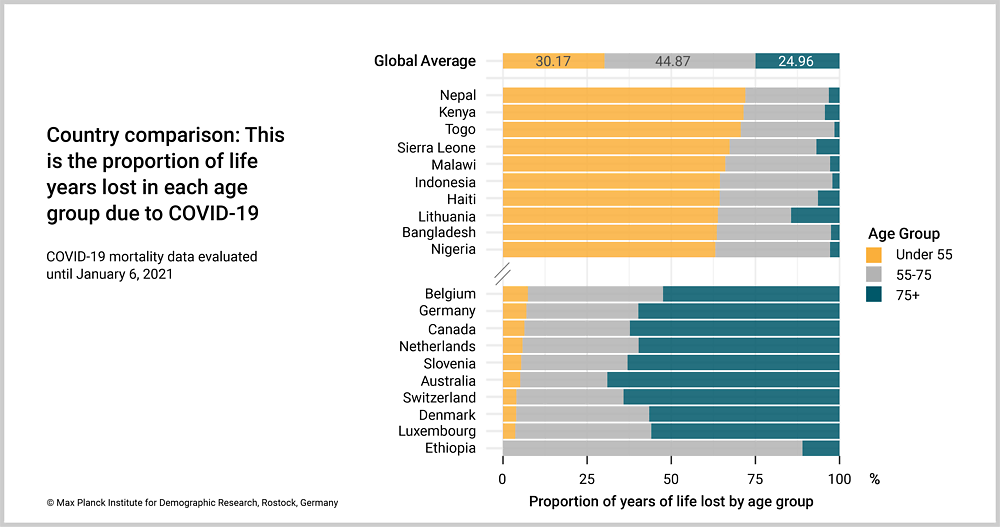February 18, 2021 | Press Release
Covid-19 Deaths Worldwide: Taken Together, People Under 75 Account for Most of the Years of Life Lost

On average globally, three-quarters of the years of life lost are accounted for by decedents who were younger than 75. © iStockphoto.com/Tomas Ragina
To properly assess the impact of the COVID-19 pandemic on mortality, it is not enough to only count the number of dead. That's why an international team of researchers evaluated more than 1.2 million deaths attributed to COVID-19 in 81 countries to learn how old the people who died from COVID-19 were, and how much their lives were shortened compared to the average life expectancy.
Globally, the researchers estimate that nearly 20.6 million years of life have been lost. “Middle aged people and those in early retirement bear the largest share of total years of life lost in global comparison”, says Mikko Myrskylä, Director of the Max Planck Institute for Demographic Research (MPIDR) in Rostock, Germany. Together with Héctor Pifarré i Arolas from Universitat Pompeu Fabra in Spain, he led the international team of researchers.
Deaths at very old ages can be considered to result in fewer years of life lost when compared to deaths at very young ages. On a global average, barely 25 percent of the years of life lost are accounted for by victims who were older than 75 years, while 45 percent of the years of life were lost by people between the ages of 55 and 75, and the population under 55 accounts for 30 percent of the years of life lost worldwide. In other words, three quarters of the years of life lost are accounted for by decedents who were younger than 75.
This is in stark contrast to the commonly held belief that mainly people with a few years to live died from COVID-19. “Therefore, measures should also be taken to protect younger parts of the population,” says Mikko Myrskylä.

The chart shows the ten countries in the study where the proportion of years of life lost is highest in the youngest age group; and those ten countries where this proportion is smallest. In between are 61 countries that are not included in this chart. The graph does not show how many people died from COVID-19 in each country.
Download figure (PNG File, 286 kB)
The details show that in high income countries the population over the age of 75 bears a significantly larger share of the years of life lost than the youngest population group - those under 55. This picture is exactly reversed in medium and low income countries. Here, the proportion of life years lost is greater in the youngest population group.
The researchers also found that populations in strongly affected countries, such as Italy and the United States, lost up to nine times more years of life than they would have had during an average flu season.
Capturing mortality with appropriate methods
There is much debate about appropriate methods to collect COVID-19 mortality as accurately as possible. “Each method has its own strengths and weaknesses,” says Mikko Myrskylä.
The Infection fatality rate only captures the subset of people whose COVID-19 infection has been confirmed. Without knowing the actual number of infected people, it is difficult to estimate infection mortality using demographic models.
The number of deaths attributed to COVID-19 may overestimate or underestimate the actual number of COVID-19 deaths because it depends on the criteria by which a death is recorded as a COVID-19 death which differ from country to country.
The method of recording total excess mortality involves comparing mortality rates during the pandemic with a baseline value derived from previous years. Estimating this baseline correctly is difficult.
Because of these and other methodological challenges, the results of the new study are only a snapshot during the ongoing pandemic and may overestimate or underestimate the actual number of life years lost.
“Nevertheless, our results confirm that the impact of the pandemic on mortality is large, not only in terms of absolute number of deaths, but also in terms of years of life lost,” says Mikko Myrskylä.
Original Publication
Pifarré i Arolas, H., Acosta, E., López Casasnovas, G., Lo, A., Nicodemo, C., Riffe, T., Myrskylä, M.: Years of life lost to COVID-19 in 81 countries. Scientific Reports (2021). DOI: 10.1038/s41598-021-83040-3
Authors und Affiliations
Héctor Pifarré i Arolas, Centre for Research in Health Economics, Universitat Pompeu Fabra
Enrique Acosta, Max Planck Institute for Demographic Research, Rostock
Guillem López Casasnovas, Centre for Research in Health Economics, Universitat Pompeu Fabra
Adeline Lo, Department of Political Science, University of Wisconsin-Madison
Catia Nicodemo, Centre of Organisation, Department of Primary Economics, University of Oxford
Tim Riffe, Max Planck Institute for Demographic Research, Rostock
Mikko Myrskylä, Max Planck Institute for Demographic Research, Rostock